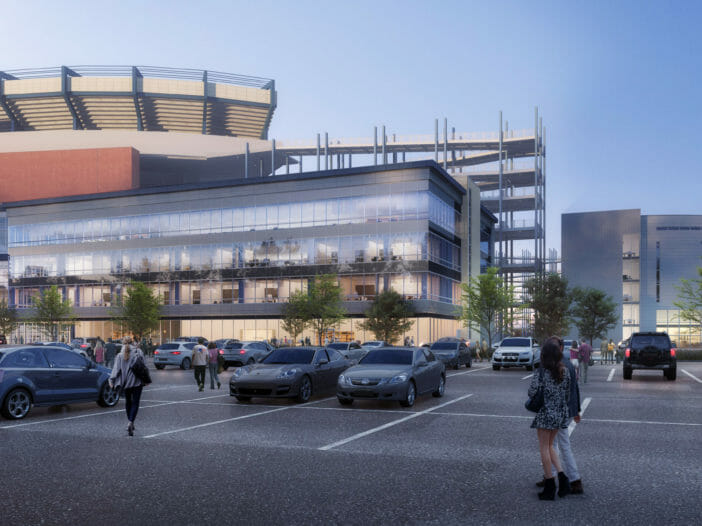By: Brooks Slocum, AIA + Adam Spagnolo
As 2022 races to the finish line, it is important to take a moment to reflect on what we’ve accomplished this year and set our sights on what’s next. At SGA, that involves celebrating innovative projects in the Boston area, unique undertakings in New York City, and setting our sights on New Jersey, which, according to the state’s Economic Development Authority, has been the “medicine chest” to the world for decades.
This established and resurgent market is the backbone between Massachusetts, New York, and Pennsylvania, and is primed for new and updated developments in the Life Sciences industry. SGA CEO Adam Spagnolo and his team are ready to write the next chapter with a thoughtful approach to the creation and design of new Life Sciences facilities across the state. “New Jersey’s existing campus infrastructure offers the potential for an ecosystem that rivals San Francisco’s Silicon Valley and Boston’s 95 corridors,” Spagnolo explains. “The market can service the entire Life Sciences development pipeline ranging from discovery through production and distribution.” He notes that the Princeton area is a perfect example, offering a mix of tenants seeking ultra-speed to-market repositionings that are essentially convert-to-suits.
Unlike the dense urban settings in Cambridge and Manhattan, the state of New Jersey already has the infrastructure to support multi-business new developments and reimagined single-cluster facilities, all within proximity to some of the country’s lead research universities. A prime representation of this innovation is the New Jersey Center of Excellence owned by Thor Equities. This development has been transformed into a multi-tenant cluster for tenants seeking high-tech R&D campuses in a desirable location without the cost-prohibitive commitment of a dedicated, built-to-fit structure.
In addition to being the home of 48 colleges and universities, New Jersey is uniquely positioned to serve as both a talent feeder and a growth accelerator. This is most evident in the integration of Life Sciences centers and amenities into existing college campuses, which not only strengthen the talent pool but also provide added value through modernization and opportunities for income. Universities want their facilities to reflect the building and lab types that students will experience after graduating, while major players are keen on development opportunities that are in close proximity to institutions and will attract tenants.
“The Life Science buildings in the commercial market are designed to be very flexible and university labs have traditionally been more set in their layouts,” shares SGA Principal Brooks Slocum, AIA. “However, the new structures being built on campuses today have designs that allow for maximum flexibility, more closely matching the overall design flexibility in state-of-the-art life science commercial buildings.”
Although university settings were previously thought of as places where dorm room miracles are born, the maturity of the existing market in New Jersey makes a case for sustained growth rather than venture-backed startups.
One doesn’t have to drive through the sprawling suburbs of the Garden State to appreciate how it has embraced its legacy as one of the largest Pharmaceutical and Biotech markets of the 20th century. With future planning in mind, it is critical for both government officials and developers to re-imagine these existing facilities in order to catch up to the more dynamic Life Sciences markets in Boston, Cambridge, Manhattan, and in nearby Philadelphia. Whereas Philly has honed in on creating infrastructures that support gene and cell therapies, New Jersey has always been the go-to for Big Pharma. So, what will persuade the Life Sciences giants of the 21st century when it comes to choosing their home base?
Take, for example, the new L’Oreal facility in Clark, NJ. The redevelopment of this $140M research and innovation center was brought to fruition by close collaboration with the Union County municipality and Clark Planning Board. Both entities recognized the value of adding a 250,000-square-foot development center focused on Green Sciences and Beauty Tech to their region, which would simultaneously add over 500 highly-skilled jobs. Not only does this demonstrate a mature business’s commitment to innovation and advancement, but also how to effectively partner with and better integrate into the surrounding community.
This illustrates a growing, positive trend of sophisticated developers collaborating with the local municipalities to get their development plans approved. In order to be awarded entitlements in prime areas, savvy developers should be planning flexible facilities that can evolve into different uses throughout the life-cycle of the building. With a strong understanding of what works in both the Cambridge and NYC markets, SGA believes that the leading New Jersey campuses will be those that best accommodate the entire facility pipeline from incubation through manufacturing and distribution.
Whereas locations like Manhattan, Long Island, and even Jersey City are attracting early-stage, tech focus, speed-to-market repositionings, with pre-built graduate or step space, and accelerators, the vast portion of New Jersey is already mature with appropriate life sciences campuses and universities that are ready for expansion and growth of existing businesses. According to the team at SGA, this is very similar to the suburban Boston market. “Princeton reminds us of Watertown, MA,” Spagnolo shares. “It took five years, but SGA’s Linx ignited the initial phase of a tremendously successful suburban sub-cluster in close proximity to a University.” With ample space and opportunity, and the right experience, New Jersey will quickly become the go-to market for developers in this field, attracting new and existing businesses that are eager to evolve.


















